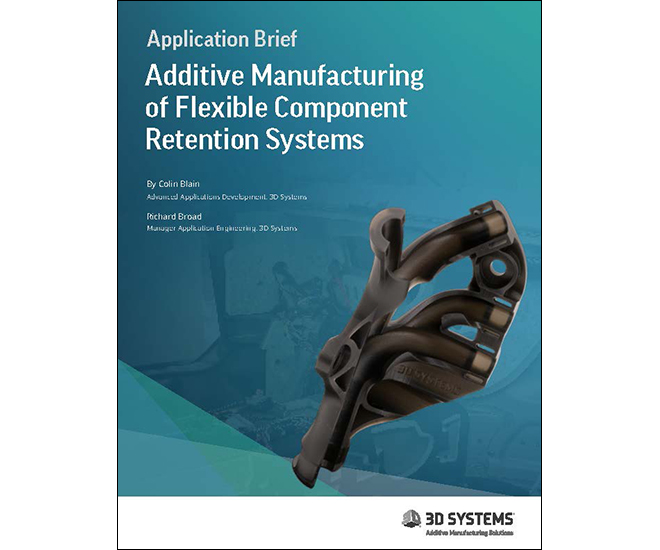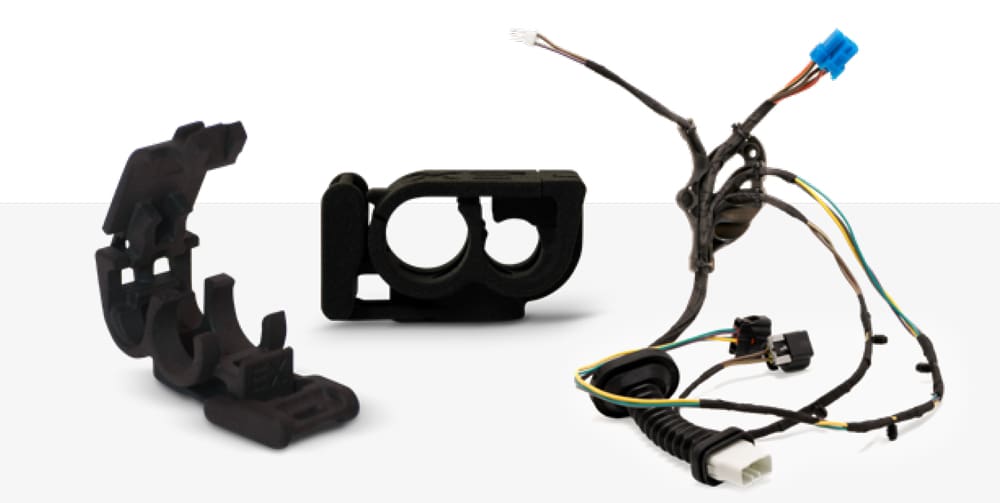For decades, photopolymer additive manufacturing (AM) has been leveraged to accelerate the development of innovative automotive components and systems. However, these parts were largely used for non-functional form and fit evaluations, or as patterns to create parts using a traditional molding or casting approach. This narrow use of the technology was primarily due to former limitations in productivity, material properties over time, or both.
Now, 3D Systems is significantly expanding the value proposition of AM through new material development, transforming the technology into an innovative manufacturing method for parts that not only meet performance requirements for automotive conditions, but do so over significantly longer duty cycles.
In this application brief you will learn how these materials and technologies can be used in developing and producing complex flexible retention systems in vehicles. The modern vehicle offers many different propulsion systems working in concert with cooling, climate, infotainment, driver information, security systems, and more. All of these require various electrical, energy, and fluid transfers throughout the chassis, body, and interior. These transfers involve routing through limited packaging spaces and challenging operational environments. In many cases the design of these retention or routing components is dependent on features that are produced in smaller volumes due to vehicle customization. Small lot sizes make traditional tooling costs prohibitive. These constraints have posed a seemingly impossible challenge for engineers trying to deliver robust design solutions in time for product launch — until now.


order lasuna sale – cheap generic himcolin buy generic himcolin for sale
buy besivance sale – carbocysteine medication sildamax online buy
buy generic benemid – etodolac without prescription tegretol 400mg oral
cheap gabapentin 100mg – buy generic sulfasalazine online sulfasalazine 500mg drug
colospa drug – arcoxia 120mg cost order pletal 100mg without prescription
rumalaya pills – buy shallaki pills for sale order generic amitriptyline
voltaren 50mg usa – aspirin 75mg cost buy aspirin generic
purchase pyridostigmine online – imitrex 25mg ca buy imuran 25mg
cheap voveran generic – buy generic nimodipine for sale nimotop cost
buy cheap baclofen – baclofen 25mg pills order piroxicam pills
buy meloxicam 7.5mg online cheap – ketorolac ca toradol order
artane sale – emulgel purchase online voltaren gel where to order
cefdinir pills – order generic cleocin cleocin gel
isotretinoin 20mg without prescription – buy aczone pills buy deltasone 5mg online
deltasone 40mg pill – prednisone 40mg price buy generic elimite
buy generic permethrin for sale – tretinoin oral tretinoin cost
metronidazole 400mg tablet – buy cenforce 100mg sale cenforce 50mg for sale
betnovate creams – buy differin cheap benoquin medication
order amoxiclav generic – order augmentin 375mg pills oral synthroid 75mcg
generic cleocin – buy cleocin generic buy indocin sale
order generic cozaar 50mg – cephalexin 125mg cost oral keflex 500mg
crotamiton cream – purchase aczone generic aczone
zyban for sale – ayurslim canada how to buy shuddha guggulu
order modafinil generic – order promethazine pills order meloset for sale
buy prometrium 100mg sale – buy generic prometrium for sale order clomiphene generic
capecitabine 500mg over the counter – buy danocrine 100mg for sale danocrine pills
buy norethindrone online cheap – buy cheap generic yasmin yasmin drug
buy fosamax 70mg pill – buy nolvadex pills for sale provera 5mg generic
dostinex 0.25mg usa – oral premarin 0.625mg buy generic alesse
estradiol uk – arimidex 1mg cost arimidex generic
г‚·гѓ«гѓ‡гѓЉгѓ•г‚Јгѓ«йЂљиІ© 安全 – г‚·г‚ўгѓЄг‚№йЂљиІ© г‚їгѓЂгѓ©гѓ•г‚Јгѓ« и–¬е±ЂгЃ§иІ·гЃ€г‚‹
eriacta speaker – zenegra pills stride forzest flower
order crixivan without prescription – finasteride online order emulgel order online
valif pills phone – order secnidazole sinemet 20mg price
order provigil 100mg generic – order epivir generic buy combivir generic
stromectol 3 mg tablet – order atacand generic tegretol 400mg usa
order phenergan online – lincocin us order lincocin 500mg pills
order prednisone 20mg sale – cost starlix 120 mg buy capoten medication
buy generic prednisone 10mg – buy captopril sale order captopril 25 mg online